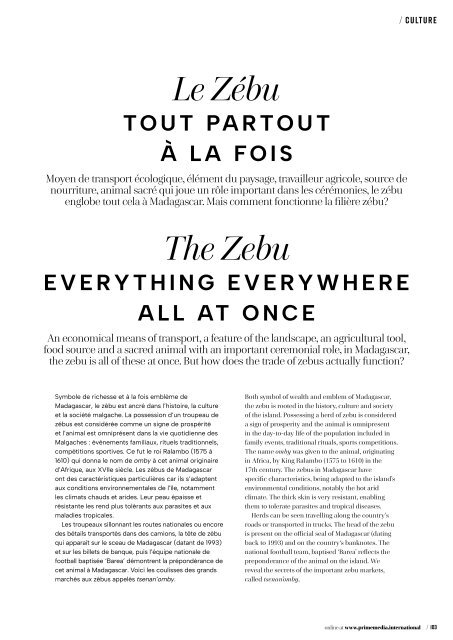Prime Magazine September 2023
Create successful ePaper yourself
Turn your PDF publications into a flip-book with our unique Google optimized e-Paper software.
culture<br />
Le Zébu<br />
TOUT PARTOUT<br />
À LA FOIS<br />
Moyen de transport écologique, élément du paysage, travailleur agricole, source de<br />
nourriture, animal sacré qui joue un rôle important dans les cérémonies, le zébu<br />
englobe tout cela à Madagascar. Mais comment fonctionne la filière zébu?<br />
The Zebu<br />
EVERYTHING EVERYWHERE<br />
ALL AT ONCE<br />
An economical means of transport, a feature of the landscape, an agricultural tool,<br />
food source and a sacred animal with an important ceremonial role, in Madagascar,<br />
the zebu is all of these at once. But how does the trade of zebus actually function?<br />
Symbole de richesse et à la fois emblème de<br />
Madagascar, le zébu est ancré dans l’histoire, la culture<br />
et la société malgache. La possession d’un troupeau de<br />
zébus est considérée comme un signe de prospérité<br />
et l’animal est omniprésent dans la vie quotidienne des<br />
Malgaches : évènements familiaux, rituels traditionnels,<br />
compétitions sportives. Ce fut le roi Ralambo (1575 à<br />
1610) qui donna le nom de omby à cet animal originaire<br />
d’Afrique, aux XVIIe siècle. Les zébus de Madagascar<br />
ont des caractéristiques particulières car ils s’adaptent<br />
aux conditions environnementales de l’île, notamment<br />
les climats chauds et arides. Leur peau épaisse et<br />
résistante les rend plus tolérants aux parasites et aux<br />
maladies tropicales.<br />
Les troupeaux sillonnant les routes nationales ou encore<br />
des bétails transportés dans des camions, la tête de zébu<br />
qui apparaît sur le sceau de Madagascar (datant de 1993)<br />
et sur les billets de banque, puis l’équipe nationale de<br />
football baptisée ‘Barea’ démontrent la prépondérance de<br />
cet animal à Madagascar. Voici les coulisses des grands<br />
marchés aux zébus appelés tsenan’omby.<br />
Both symbol of wealth and emblem of Madagascar,<br />
the zebu is rooted in the history, culture and society<br />
of the island. Possessing a herd of zebu is considered<br />
a sign of prosperity and the animal is omnipresent<br />
in the day-to-day life of the population included in<br />
family events, traditional rituals, sports competitions.<br />
The name omby was given to the animal, originating<br />
in Africa, by King Ralambo (1575 to 1610) in the<br />
17th century. The zebus in Madagascar have<br />
specific characteristics, being adapted to the island’s<br />
environmental conditions, notably the hot arid<br />
climate. The thick skin is very resistant, enabling<br />
them to tolerate parasites and tropical diseases.<br />
Herds can be seen travelling along the country’s<br />
roads or transported in trucks. The head of the zebu<br />
is present on the official seal of Madagascar (dating<br />
back to 1993) and on the country‘s banknotes. The<br />
national football team, baptised ‘Barea’ reflects the<br />
preponderance of the animal on the island. We<br />
reveal the secrets of the important zebu markets,<br />
called tsenan’omby.<br />
online at www.primemedia.international / 103
















